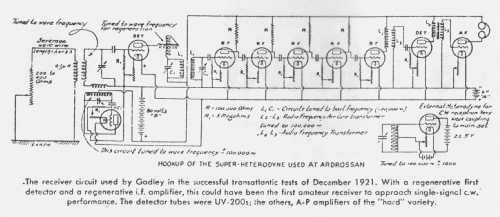Transatlantic Super-Heterodyne
Homebrew - ORIGINAL, USA
- Produttore / Marca
- Homebrew - ORIGINAL, USA
- Anno
- 1921
- Categoria
- Radio (o sintonizzatore del dopoguerra WW2)
- Radiomuseum.org ID
- 342499
Clicca sulla miniatura dello schema per richiederlo come documento gratuito.
- Numero di tubi
- 10
- Valvole
- UV200 A_Moorhead A_Moorhead A_Moorhead A_Moorhead A_Moorhead A_Moorhead UV200 A_Moorhead A_Moorhead
- Principio generale
- Supereterodina (in generale)
- Gamme d'onda
- Onde medie e lunghe in una sola gamma.
- Tensioni di funzionamento
- Batterie (di accumulatori e/o a secco) / 6 & 80 & 22,5 Volt
- Altoparlante
- - Questo apparecchio richiede altoparlante/i esterno/i.
- Materiali
- Mobile in legno
- Radiomuseum.org
- Modello: Transatlantic Super-Heterodyne - Homebrew - ORIGINAL, USA
- Forma
- Soprammobile a cassapanca o cassetta, solitamente con coperchio (NON a leggio)
- Annotazioni
-
A Super-Heterodyne used at Ardrossan.
The receiver circuit used by Godley in the succesful transatlantic test of December 1921. With a regenerative first detector and a regenerative i.f. amplifier, this could been the first amateur receiver to approach single-signal c.w. performance.The detector tubes were UV-200s, the others, A-P amplifiers of the "hard" variety.
This is the original legend of the schematic.
From an article by Sergio Pandolfi on "Radio Rivista" official organ of "ARI Amateur. Radio Association." of Italy, April 1976.
This receiver was built for the transatlantic tests done in November 1921. The receiver was used to listen to the time signals.
- Bibliografia
- “Radio Rivista” official organ of "ARI Amat. Radio Assoc." of Italy, number 1, January 1978.
- Autore
- Modello inviato da Pier Antonio Aluffi. Utilizzare "Proponi modifica" per inviare ulteriori dati.
- Altri modelli
-
In questo link sono elencati 36 modelli, di cui 20 con immagini e 5 con schemi.
Elenco delle radio e altri apparecchi della Homebrew - ORIGINAL, USA
